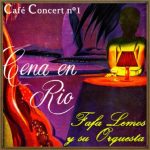FAFA LEMOS

Biography
Fafa Lemos was an important Brazilian musician in the ’40s through the ’70s. A violin virtuoso hired by the most significant radio station (Nacional, which was heavily financed by the nationalist government of Getúlio Vargas), he played with virtually all of the Brazilian stars of those times, recorded a great solo discography (in Brazil and the U.S.), and also had an appreciable solo career abroad.
His musical studies began at seven. With the accompaniment of the Orquestra Sinfônica do Teatro Municipal do Rio de Janeiro, under conduction of maestro Burle Marx, he soloed a Vivaldi concert only two years later. In the next year, he played at the prestigious National Institute of Music, accompanied by renowned pianist Souza Lima. Moving to Paraná, he abandoned music for four years to complete his high school studies. In 1940, he returned to Rio and joined the Brazilian Symphonic Orchestra for four months and the Carlos Machado Orchestra (in which he would work for six years) at the luxurious Cassino da Urca. Accompanying Carlos Machado, he began playing at the Casablanca nightclub in 1946, but the Trio Rio (which played at Bally-Hi nightclub) made a better proposal and he joined them.
In 1950, Rádio Nacional hired him for the outing’s cast and in that capacity, he would accompany the Brazilian musical who’s who of those times. In 1952, he went to the U.S. for the first time — he would go there several times — and on one of those trips, he recorded the soundtrack to the film Meu Amor Brasileiro (Mervyn Le Roy, Metro) with Laurindo Almeida. Accompanying Carmen Miranda, they toured several American cities. For New York’s CBS, he recorded three TV shows and was hired by Hollywood’s KTV as a soloist.
Also in 1952, he recorded several albums for the American RCA Victor. Some time before, Paulo Tapajós, musical director for Rádio Nacional, created the show Música em Surdina (music in mute), under the winning concept of taking the excellent soloists hired by the station from the orchestral mass and putting them in small groups. So, Tapajós created the Trio Surdina: Lemos, Garoto (violão and several other string instruments), and Chiquinho do Acordeon (accordion). Sometimes the trio was joined by Vidal (bass) and Bicalho (percussion). After prime time, they would entertain the listeners for hours, playing refined instrumental music until the daily closing of the broadcasts. Playing international music in Brazilian rhythms, they also incorporated Noel Rosa classics (“Com que Roupa?” sung by Fafa Lemos); “Ninguém me Ama” (Antônio Maria/Fernando Lobo, a hit in the voice of Nora Ney); and the trio’s own compositions, such as the choro “Relógio da Vovó” and the baião “Nós Três.” In 1953, the trio released the first of a series of LPs (Musidisc): Garoto’s “Duas Contas,” which can be considered a precursor of bossa nova, regarding lyrics, harmony, and melody.
Tied by contract to the radio, the trio was emulated by some or all of its members in recordings for singers under a great deal of denominations. For example, “Vingança” (Lupicínio Rodrigues) was recorded by Linda Batista in 1951 (RCA), where pianist Carolina Cardoso de Meneses subbed the accordion of Chiquinho’s, and “Risque” (Ary Barroso) was recorded next year by the same singer, this time with the exact formation of Trio Surdina. The extraordinary success of the trio, a format obsessively adopted by nightclubs and recording companies after them, was also in part credited to the extinction of gambling in Brazil by president Dutra in 1946. The biggest musician employers were the big casinos, which presented an array of sophisticated entertainment besides gambling, music being one of the most important. Those musicians became unemployed overnight and created pocket shows in the nightclubs that took the place of the casinos: Night & Day, Casablanca, Monte Carlo, and others.
In 1953, Fafa Lemos returned to the U.S., touring and recording with Carmem Miranda until her death in 1955. Forming a trio, he performed at the Marquis restaurant for over a year and at the Frascati restaurant for five months. In 1956, he returned to Brazil and became artistic director for RCA Victor, releasing all of his solo recordings on 78 rpms in the U.S. In 1958, he shared an album with Luiz Bonfá (Bonfafá, Odeon). Lemos performed in nightclubs and TV shows until 1961, when he moved again to the U.S. In 1964, he appeared as guest artist on Laurindo Almeida’s Guitar From Ipanema



 Café Concert With Fafa Lemos
Café Concert With Fafa Lemos Brazilian Lounge Songs, The Vintage Club
Brazilian Lounge Songs, The Vintage Club Music For Dinner, "Violins"
Music For Dinner, "Violins" 100 Vintage Relaxing Music
100 Vintage Relaxing Music



